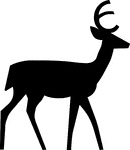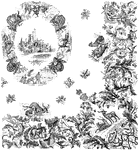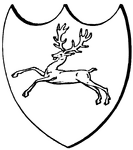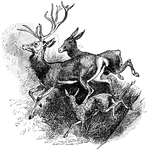
Deer Viewing Area, Silhouette
This sign is used to indicates that it is likely that deer can be seen nearby.

Wood Carving
This wood carving is sculptured in alto-relievo which is a high relief. The design shows field animals…

Table Cloth
This table cloth is was made for the Queen Victoria of the United Kingdom. It has scenery of deer stalking,…

Teapoy
The teapoy is a type of container used to store tea during the 19th century. This teapoy is lavishly…

Reindeer
Also known as the caribou. It is part of the deer family, commonly found in the Artic and Subartic.

Skeleton of the Deer
"The bones in the extremities of this the fleetest of quadrupeds are inclined very obliquely towards…

Heart of a Deer
"Cast or mold of the interior of the left ventricle of the heart of a deer. Shows that the left ventricular…

Compressed Foot
An extreme form of a compressed foot, typically seen in the deer and ox. It is useful for land transit.

Leopard
The leopard (Felis pardus) is a carnivore closely allied to the lion and the tiger, but differing it…

Puma
The puma, also known as the cougar, panther, or mountain lion (Felis concolor) , is a large American…
![Drawing of the Diana of Versailles, a 2nd-century Roman version in the Greek tradition of iconography. In Roman mythology, Diana ([djana]) was the goddess of the hunt, the moon and childbirth, being associated with wild animals and woodland, and having the power to talk to and control animals.](https://etc.usf.edu/clipart/188200/188203/188203-diana-of-versailles_mth.gif)
Diana of Versailles
Drawing of the Diana of Versailles, a 2nd-century Roman version in the Greek tradition of iconography.…

Hart at Speed on Heraldic Badge
Illustration of a heraldic badge decorated with a hart, running. The hart is a common symbol in heraldry.



